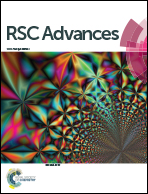A facile approach to synthesizing S–Co–O tridoped g-C3N4 with enhanced oxygen-free photocatalytic performance via a hydrothermal post-treatment†
Abstract
Extending the application of photocatalytic oxidation technology to the anoxic removal of organic pollutants that exist under some oxygen-free conditions is attractive but challenging. In this study, S–Co–O tridoped g-C3N4 nanorods with outstanding visible light activity under anoxic conditions are synthesized via hydrothermal post-treatment. S and Co doping inhibits the crystal growth of graphitic carbon nitride, enhances the SBET, decreases the band gap energy and increases the separation efficiency of photogenerated electrons and holes, which increases the anoxic photocatalytic RhB degradation constants by approximately 4.5 times. After hydrothermal treatment, oxygen doping not only increases the adsorption ability of graphitic carbon nitride but also captures photogenerated electrons to produce photogenerated holes for RhB degradation under anoxic conditions, leading to a tripling of the RhB degradation constant. This study provides new insight into the design and fabrication of oxygen-free photocatalysts.


 Please wait while we load your content...
Please wait while we load your content...